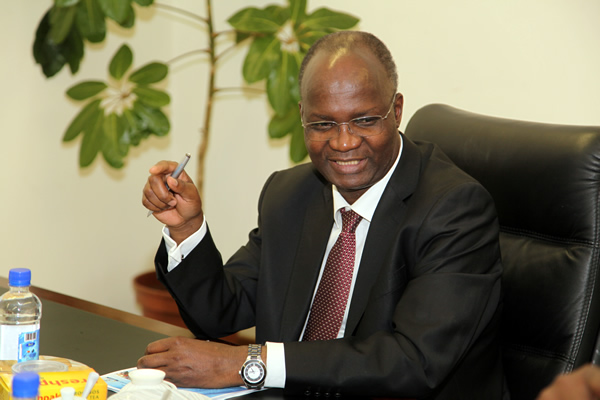Prof Moyo bristles at Mavhima attacks


Minister of Higher and Tertiary Education, Science and Technology Development Professor Jonathan Moyo
Auxilia Katongomara Chronicle Reporter–
THE Minister of Higher and Tertiary Education, Science and Technology Development Professor Jonathan Moyo has launched a passionate defence of his ministry’s new technology and engineering thrust following criticism by Primary and Secondary Education deputy minister Prof Paul Mavhima. Prof Moyo said STEM, which stands for Science, Technology, Engineering and Mathematics, was a long overdue initiative as tertiary institutions were struggling to get enough students for pure sciences.
Prof Paul Mavhima criticised the initiative as “misplaced” and “illogical” in a stinging opinion piece in The Herald. He continued the attack in Bulawayo on Tuesday, arguing that Prof Moyo’s ministry was creating an impression that STEM was a new phenomenon when the government had established several tertiary institutions to promote learning of sciences.
But addressing guests at the STEM draw held at a Bulawayo hotel on Thursday night, Prof Moyo said the STEM initiative was supposed to be implemented “as soon as yesterday.”
He said most tertiary institutions were struggling to meet their enrolment capacity in pure sciences, which was testimony that something needed to be done urgently.
“You heard that in some cases they can’t even get 30 students in a Physics or Mathematics class. We’re not even talking about that, we’re talking about people who can do software engineering, people who can do reverse engineering, people who can create new knowledge and have us patent that new knowledge as Zimbabwe’s intellectual property,” he told an audience of government ministers, headmasters and beneficiaries of the ministry’s STEM school fees scheme.
He went on: “Our universities don’t have these students, NUST was created as a science university, a technology university, a STEM university, but it has been a university for commercial studies. The graduates coming out of that university have not been STEMITISED, they’re not even pure science students. Ask them ‘why?’
“The answer that they’ve given us and the answer they gave his Excellency (President Mugabe) last year is that they can’t find the students.” Without identifying him by name, Prof Moyo took a dig at Mavhima’s suggestion that STEM has been part of higher education since 1980. He said while Science and Maths have been with us for a while, this was not so with technology and engineering.
“In the acronym STEM, the first letter S is common, it’s the summary that speaks to Physics, Chemistry, Biology and the last letter M is also very, very important it affects all fields whether they’re STEM fields or non-STEM fields,” he explained.
“But what’s STEMATIC in STEM is not these subjects, it’s the T and E, the Technology and Engineering. That’s what STEM is, technology and engineering, not simply Physics, Chemistry and Biology on one hand or Mathematics.
“We’re hearing a lot of people running around saying they’re doing STEM simply because they’re teaching these pure subjects, that’s wrong. These subjects have been taught since time immemorial and what our country critically needs is the T and E which is Applied Science.”
Warming up to his theme, he bristled at a suggestion by Prof Mavhima that the Higher Education ministry, which is paying full fees for some 4,200 students who took up STEM subjects at Lower Sixth last term, should expand the investment and target children who are in pre-school.
“There’s no way for us to start except with the students who’ve taken their O-Levels,” Prof Moyo said. “We’re agreeing with the view that we must have a holistic approach, which to those who’re of that view means we should start at ECD or infant. We’re agreeing with that view, but we hope that those with that view will also respect the division of labour,” he said.
Prof Moyo said President Mugabe’s decision to split the ministries of education, one focused on primary and secondary and the other on tertiary was an indication that the two ministries had different roles and mandates to carry out.
“In that scheme of division of labour, under which the tasks are assigned by his Excellency the President, ours are to plan, train and develop human capital skills. We can’t do that by going to the infant level, that’s not our job. It’s somebody else’s job and we hope they do their job and we’re prepared to support them.
“Our job necessarily starts with O-Level school leavers who’re now out there going into the labour market, who’re thinking careers, who’re thinking what degree or what diploma to pursue, and some who directly seek enrolment at our tertiary institutions, the polytechnics and teachers’ colleges and a privileged few who go on to A-Level in order to prepare for university.
“We’re particularly interested in that group and because you must start somewhere, we’ve decided to start with the 2016 A-Level group in order to respond to the challenges that Professor Mwenje shared with you, where the enrolments at our science universities have dramatically gone down.”
The STEM initiative, he said, had to start somewhere, and the fastest route to getting ‘STEMITISED’ graduates was to start with the A-Level class of 2016.
“We can’t start last year because we missed the boat, so we must start this year and as we start this year we understand that it takes no less than seven years to educate a STEMITISED engineer, it takes at least 10 years for that STEMITISED engineer to become relevant in the production of engineering and technological solutions needed by society,” he said.
“So we’re starting this in 2016 with a clear understanding that we should expect results only in 2026. Those who say we must start at infant level and if their programme starts next year they must know that it takes 16 years for that infant to go through A-Level and it’s going to be 2033 when that infant is relevant to society in terms of coming up with technological and engineering solutions.”
Guest of honour, Vice President Phelekezela Mphoko, said the STEM initiative was critical in transforming the country from a resource based-economy to a high tech knowledge-driven economy.
Mphoko said in order to achieve this, Zimbabwe needs to embrace the role of science and technology and invest in it accordingly.
“The STEM initiative is a national strategy to achieve defined national socio-economic goals as defined in the ZIM-ASSET economic blueprint and the country’s industrialisation policy through a strategic human capital development plan,” he said.
“There shouldn’t be any doubt that STEM professions are the headlights for this country’s future economic prosperity and with STEM, our nation stands to unlock the power with which to engineer the master code of the jobs of the future.”
Mphoko said the missing link for an industrial breakthrough of a revolutionary magnitude in the country has been STEM capacity in most critical areas of the economy.
“Technology is such a critical economic asset that has given developed nations as economic edge over other regions and no reasonable country is prepared to just give it on a platter,” he said. “It’s with this realisation that without research, there’s no technology and without technology there’s no meaningful value addition to our national resources.”
The Vice President encouraged student beneficiaries to work hard and make the government’s investment in education a success. Among the ministers present were Saviour Kasukuwere (Local Government), Prisca Mupfumira (Public Service), Tshinga Dube (War Veterans) and Christopher Mushohwe (Information).












Comments